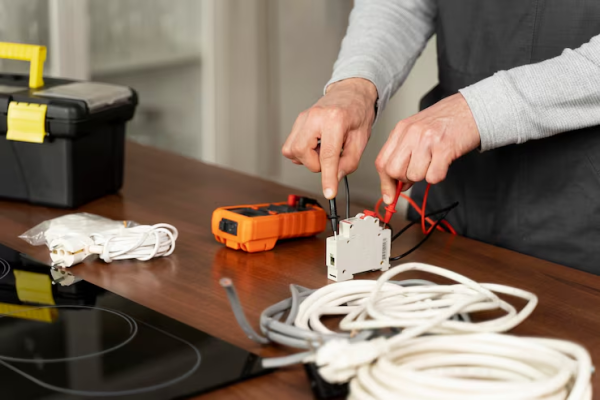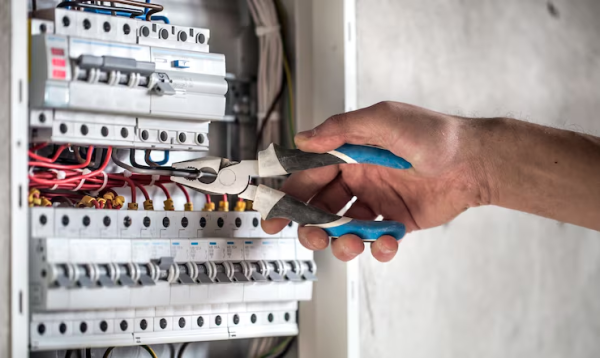What Electrical Service Do I Need
Choosing the right electrical service size is essential for powering your home safely and efficiently, whether you’re building, remodeling, or upgrading an older panel. Service size, measured in amps, determines how many circuits, appliances, and future upgrades your home can handle, with 100-amp service fitting smaller homes and 200-amp service now considered the standard for modern households with higher energy demands. Factors such as home size, heating and cooling systems, appliances, lifestyle, and future plans all play a role in selecting the right capacity, while warning signs like frequent breaker trips or flickering lights may indicate it’s time for an upgrade. Since electrical service impacts both safety and long-term functionality, consulting a licensed electrician for a load calculation and proper installation ensures your home is prepared for current and future needs. DW Utah offers professional service upgrades to keep your home safe, reliable, and ready for modern living.
Ogden, Utah, United States, 25th Sep 2025 – When it comes to powering your home, one of the most important decisions you’ll make is choosing the right size electrical service. Whether you’re building a new home, remodeling, or upgrading an older electrical panel, selecting the correct service size will determine how safely and efficiently your home can meet your energy needs. Many homeowners wonder: What electrical service do I need?
The answer depends on several factors, such as the size of your home, the number of appliances you use, and whether you plan to add more electrical demands in the future. This article will break down the different service sizes, explain how to plan for your home’s power needs, and provide practical tips for making the right decision.

Understanding Electrical Service Size
Electrical service size refers to the total capacity of electricity that can be safely supplied to your home. It’s measured in amperes, or amps, which indicate the maximum flow of electrical current available. The most common service sizes for residential properties are 100 amps and 200 amps, although some larger or specialized homes may require more.
The electrical service size you choose will determine:
- How many circuits you can have in your home.
- How many appliances and devices you can run simultaneously.
- Whether your system can handle future upgrades, such as adding central air conditioning, an electric vehicle charger, or a hot tub.
Why Service Size Matters
Choosing the correct service size is not just about convenience—it’s about safety and long-term planning. If your service size is too small for your electrical needs, you may experience:
- Frequent tripped breakers.
- Overloaded circuits.
- Potential fire hazards due to overheated wiring.
- Limited ability to add new appliances or systems.
On the other hand, selecting the right service size ensures that your electrical system can safely handle your household’s needs today and in the years to come.
Common Residential Service Sizes
100-Amp Service
A 100-amp service can provide enough power for a small home without electric heating. This level of service can typically handle:
- Basic lighting and receptacle outlets.
- An electric range.
- A clothes dryer.
If you live in a smaller home or cabin, and you don’t rely on high-energy systems like electric heating or central air conditioning, a 100-amp service may be sufficient. However, it’s becoming less common in new homes as energy demands increase.
200-Amp Service
A 200-amp service is considered the current standard for new homes and for panel upgrades. It provides ample power for modern households, which often include:
- Central heating and air conditioning systems.
- Electric ranges, ovens, and dryers.
- Dishwashers and other kitchen appliances.
- Hot tubs or pool equipment.
- Home office setups and entertainment systems.
With more people working from home and adding energy-demanding systems such as EV chargers, 200-amp service gives you the flexibility and peace of mind that your system can handle both current and future needs.
Factors to Consider When Choosing Electrical Service Size
1. Home Size and Layout
The larger the home, the more circuits and outlets you’ll need. Bigger homes generally benefit from 200-amp service or higher, especially if they include multiple kitchens, bathrooms, or home theaters.
2. Heating and Cooling Systems
If your home uses electric heating, baseboard heaters, or central HVAC systems, these can quickly add to your power demand. A smaller 100-amp service may not be able to keep up with these loads.
3. Appliances and Lifestyle
Think about your everyday appliances. Do you have multiple refrigerators, a double oven, or laundry equipment that runs often? Do you or your family members work from home with several computers and devices running at once? These factors all increase your electrical needs.
4. Future Plans
Upgrading your service size now can save you from having to make another costly upgrade later. If you’re planning to install a hot tub, solar panels, or an electric vehicle charger, 200 amps may be the smarter choice.
5. Safety and Code Requirements
Local electrical codes and safety regulations may also dictate the minimum service size for your home. A licensed electrician will ensure that your system meets current standards and is safe to operate.
Tips for Planning Electrical Service Size

Conduct a Load Calculation
A load calculation is a detailed analysis of your home’s electrical usage. It considers the square footage of your home, the number of circuits, the type of appliances, and future needs. This calculation can help you and your electrician determine whether 100 amps, 200 amps, or more is required.
Think Long-Term
It’s always best to plan for growth. While 100 amps might be enough for a smaller home today, many homeowners eventually upgrade to 200 amps as their energy needs expand. Consider how your household may change over the next 10 to 20 years.
Evaluate Panel Space
Even if your home doesn’t currently need 200 amps, a larger panel with more breaker spaces may still be worthwhile. This gives you flexibility for future upgrades without requiring a complete replacement.
Consider Energy Efficiency
Energy-efficient appliances and lighting can reduce your overall power demand, but they don’t eliminate the need for a properly sized service. Efficiency helps, but capacity remains essential.
Work with a Licensed Electrician
Electrical service upgrades are not DIY projects. They involve complex wiring, permits, and coordination with your utility provider. Always hire a licensed electrician to assess your needs and perform the work safely.
Signs It’s Time to Upgrade Your Electrical Service
If you’re unsure whether your current service is meeting your needs, look for these warning signs:
- Lights dim or flicker when appliances turn on.
- Breakers frequently trip or fuses blow.
- You rely heavily on power strips and extension cords.
- You plan to add new, high-demand appliances.
- Your current panel is outdated or damaged.
Upgrading your service not only improves safety but also increases your home’s value and ensures you’re prepared for modern living.
How Electrical Service Upgrades Work
When you decide to upgrade your service, your electrician will:
- Perform a load calculation to determine the appropriate size.
- Obtain permits and coordinate with your utility company.
- Replace the electrical panel with one that meets your needs.
- Upgrade wiring and grounding if necessary.
- Inspect the system to ensure it meets safety codes.
This process requires professional expertise, and while it represents an investment, it’s one that pays off in reliability, safety, and peace of mind.
Cost Considerations
The cost of upgrading electrical service can vary depending on:
- The size of the service (100 amps vs. 200 amps or more).
- The complexity of the installation.
- The condition of your existing wiring.
- Local permit and utility fees.
While upgrading to 200 amps may cost more upfront, it can prevent costly problems later and provide flexibility for future needs. It’s a smart investment in your home’s safety and functionality.
Final Thoughts: Choosing the Right Service Size
So, what electrical service do you need? For smaller homes without major electric heating or high-energy appliances, 100-amp service may be sufficient. However, for most modern households, 200-amp service has become the standard and provides the flexibility you need for current and future demands.
The best way to determine the right size for your home is to consult with a licensed electrician who can perform a load calculation, review your lifestyle needs, and advise you on the safest and most cost-effective solution.
Conclusion
Upgrading or selecting the right electrical service for your home is one of the most important decisions you can make for safety, convenience, and long-term planning. While a 100-amp service may work for a smaller home with limited needs, the majority of modern homes benefit from the capacity and flexibility of a 200-amp service.
Don’t leave your home’s electrical future to chance. Work with trusted professionals who can guide you through the process, ensure your system is safe, and prepare your home for years of reliable power.
Ready to upgrade or need advice on your electrical service size? Call DW Utah today at (801)-845-0016 and let our licensed electricians help you choose the best solution for your home.
DW Utah, LLC
190 W 33rd Street Ogden, Utah 84401
(801) 845-0016
Company Details
Organization: DW Utah, LLC
Contact Person: DW Utah, LLC
Website: https://www.dwutah.com/
Email: Send Email
Contact Number: +18018450016
Address: 190 W 33rd Street Ogden, Utah 84401
Address 2: 190 W 33rd Street Ogden, Utah 84401
City: Ogden
State: Utah
Country: United States
Release Id: 25092534429

